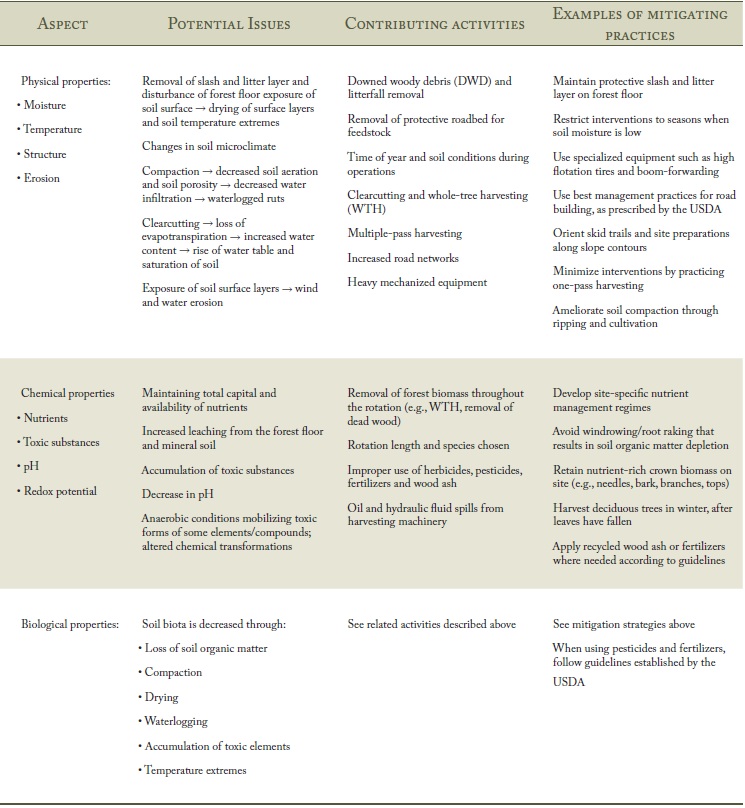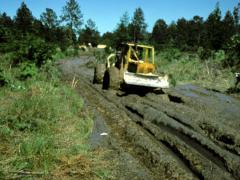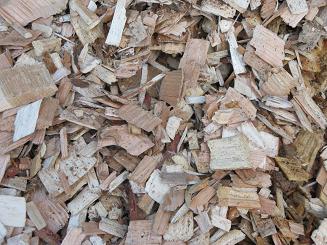Soils are the biophysical foundation upon which forests thrive and grow. The productivity of forests depends upon the quality and health of the soil blanketing the landscape. Forest managers have direct control over silvicultural systems and harvesting operations that directly affect soil quality. Knowing how to conserve and improve the soil resource is essential to sustainable forest bioenergy production systems. This can only be done practically by foresters and landowners who understand the physical and chemical properties of soils and how they are affected by forest management.
Materials usually left in the forest during conventional forest management (e.g., low-quality trees, deadwood and residues) can be removed for bioenergy feedstocks, resulting in more intensive biomass extraction on sites managed for bioenergy in addition to traditional forest products. Increased forest biomass harvesting and residue removal increases the risk of negative site impacts. Take care to ensure that such operations are sustainable. The potential for nutrient depletion, organic matter removal, soil erosion, and the possibilities of soil displacement and soil compaction are among the major concerns to manage in a bioenergy production system.
This fact sheet summarizes these soil issues, and gives scientifically-based management recommendations. More information is available from the online forest encyclopedia (http://www.forestencyclopedia.net) or your state Natural Resource Conservation Specialist, Cooperative Extension or forestry professionals. Table 1 includes a concise summary of the potential effects of bioenergy production on soil’s physical, chemical and biological properties.

Table 1. Potential Environmental Impacts of Bioenergy Harvesting on Soils
Nutrient Management
Forest managers and landowners should practice site-specific nutrient management. The goal is to maintain or improve ecosystem health and nutrient availability to plants and animals. Such a regime would balance factors that deplete nutrients from the soil against those that replenish nutrient supplies. For example, on sites where nutrient availability is limited by various soil-related factors or past harvesting removals, leave the foliage of harvested trees on site in order to retain the relatively high proportion of nutrients contained in this part of the tree. The good news is that this practice may not significantly reduce the availability of high-quality biomass for bioenergy feedstocks, since foliage is of less value for bioenergy than the woody tree components. If foliage retention is not possible on sites that have been diagnosed with deficiencies, forest managers should consider applying fertilizer (Image 1) or an appropriate form of recycled wood ash. Studies have shown that biomass removal does not significantly reduce nutrient availability on most sites1. A balanced nutrient management regime that includes nutrient replenishment, monitoring, and selection of appropriate harvesting and site preparation techniques will ensure the long-term sustainability of forest soil productivity.

Image 1. Apply fertilizer to sites diagnosed with nutrient deficiencies source: Dave Powell, USDA Forest Service
Organic Matter Conservation
Soil organic matter moderates soil temperature, increases water infiltration and holding capacity, and serves as food and energy for soil organisms. Plant nutrients are also held within soil organic matter, which is the most important source of nitrogen in forest ecosystems. Removing or decreasing soil organic matter, especially forest litter layers on the soil surface, can have negative consequences. Harvesting biomass for bioenergy can increase the risk of excessive removals of organic matter. Removing organic layers and exposing mineral soils can increase the soil temperature of a specific site. While this can actually promote growth in colder climates, in warmer climates like the southern United States, it may be necessary to retain or add organic matter to moderate the soil temperature and stimulate growth. Retaining a suitable amount of organic matter when harvesting biomass for bioenergy has additional benefits for site hydrology and biodiversity (see relevant fact sheets).
In general, research shows harvesting causes little damage in terms of soil organic removal unless followed by mechanical disturbance of forest floor layers, soil tilling, or intense burning1. There is a greater concern for organic matter depletion when growing short rotation woody crops. Yet these crops are generally grown on highly fertile soils, and crop nutrition management typically involves regular fertilizer additions2.
Soil Water-Air Balance
Potentially, forest management practices can improve or adversely change the water-air balance of the soil. The water-air balance in the soil refers to the physical and chemical relationship between the water and air in the soil. Maintaining an optimal water-air balance is important because it affects water and nutrient uptake and root respiration of trees3. Forest bioenergy operations can affect soil water-air balance. For example, water tables can rise after a biomass harvesting operation as tree removal results in significant reductions in stand water uptake and evaporative loss. Conversely, water tables can be lowered during periods of rapid stand development and into maturity when leaf surface area and water uptake are greatest. Forest managers have several tools for managing soil water-air balance. For example, soils with high water tables can be mounded and bedded. Although costly, drainage ditches and drain tiles can be installed to lower stand water tables. Soil ripping and tillage operations can restore optimal soil water-air balance in soils that have been adversely impacted by heavy machinery. Design planting and harvesting activities with local hydrological conditions in mind, to minimize the need for costly and intensive site restoration later.
Soil erosion and displacement
Soil displacement may occur as a result of machine traffic causing the churning and removal of topsoil. Biomass removal for bioenergy is sometimes undertaken using multiple-pass interventions (i.e., waiting for felled material to dry out before removing it), increasing traffic movement across harvested sites. Increased traffic movement due to biomass harvesting increases the potential for increased erosion and depletion. In forests, most erosion (Image 2) is typically caused by water flowing across the surface of sloping terrain that has been cleared of organic matter. Reducing the number of mechanical operations, maintaining intact forest floor material and orienting site preparation operations and skid trails along slope contours can minimize the risk of soil erosion and displacement. Although forest roads can be an important potential source of sediment in streams, such adverse impacts can be mitigated through Best Management Practices (BMPs). BMP information is available through Cooperative Extension and state forestry programs for each state. Forest managers and logging supervisors must take special care to minimize soil scarification on sites with slopes greater than 10 percent. Use extra caution when considering tillage and road construction operations on erosion-prone sites.

Image 2. Take care to minimize soil erosion. source: C. D. Foster, Texas Cooperative Extension
Soil compaction
Soil compaction may occur as a result of the use of heavy machinery during harvesting and residue removal for bioenergy and site preparation operations. This also has the potential to decrease soil productivity. Yet few, if any, long-term research trials have documented lasting decreases in forest productivity due to soil compaction across harvested land (e.g. sites not located directly on skidder roads and landings)3,4,5.
Managers can train machine operators to reduce soil disturbances from machine traffic and schedule biomass removal operations during seasons when soil moisture conditions contribute to resisting machine rutting (Image 3) and scarification. Allowing machine traffic and performing certain operations during adverse soil conditions can lead to a loss of organic matter. Specialized equipment, such as high flotation tires or advanced techniques such as boom-forwarding, can prevent damage to soils from machinery. If soils are damaged during biomass removal operations, repair them using appropriate techniques for the site. For example, compaction can be reversed by ripping and cultivation. Amend scarified soils by spreading harvest residues.

Image 3. Schedule operations when soil conditions are right to avoid machine damage such as rutting, as shown. source: C. D. Foster, Texas Cooperative Extension
In addition to these major areas of concern, accumulation of toxic elements in the soil from machinery leaks6 and improper application of herbicides and pesticides, as well as changes in pHfrom uncontrolled use of recycled wood ash, can aversely affect soil chemistry on sites managed for bioenergy feedstock production. Proper maintenance of machinery and adherence to herbicide, pesticide and wood ash application guidelines should help to mitigate these potential issues7.
Conclusions
While these principles should be applied in all areas, each site should be evaluated and managed with site-specific goals for maintaining or improving soil quality. Soil quality is important for the productive capacity of any forested stand. Yet stands that are intensively managed, such as those for energy feedstock production, should have soil quality monitored closely. These techniques are just a few ways to ensure the sustainability of soil values over a long period of time.
Endnotes
1 Johnson, D.W.; Curtis, P.S. 2001. Effects of forest management on soil C and Nstorage: meta analysis. Forest Ecology and Management. 140: 227-238.
2 Shepard, J.P. 2006. Water quality protection in bioenergy production: the US system of forestry Best Management Practices. Biomass and Bioenergy. 30(4): 378-384.
3 Burger, J.A. 2002. Soil and Long-Term Site Productivity Values. In: Richardson, J.; Bjorheden, R.; Hakkila, P.; Lowe, A. T.; and Smith, C. T., eds. Bioenergy from Sustainable Forestry: Guiding Principles and Practice. Dordrecht, The Netherlands: Kluwer Academic Publishers: 165-189.
4 Morris, L. A.; Miller, R. E. 1994. Evidence for long-term productivity changes as provided by field trials. In: Dyck, W. J.; Cole, D. W.; and Comerford, N.B., eds. Impacts of Forest Harvesting on Long-Term Site Productivity. London: Chapman & Hall: 41-80.
5 Powers, R.F.; Scott, D.A.; Sanchez, F.G.; Voldseth, R.A.; Page-Dumroese, D.; Elioff, J.D.; and Stone, D.M . 2005. The North American long-term soil productivity experiment: Findings from the first decade of research. Forest Ecology and Management. 220: 31-50.
6 Miller, S., Scharf, C., and Miller M. 2002. Utilizing New Crops to Grow the Biobased Market. In: Janick, J. and Whipkey, A., eds. Trends in New Crops and New Uses. Alexandria, VA: ASHS Press: 26-28.
7 Aronsson, K.A, and Ekelund, N.G.A. 2004. Biological effects of wood ash application to forest and aquatic ecosystems. Journal of Environmental Quality. 33: 1595-1605.
